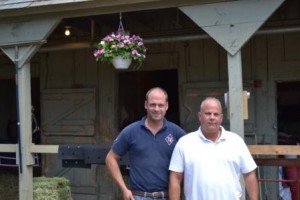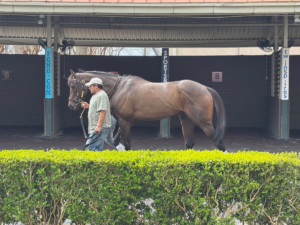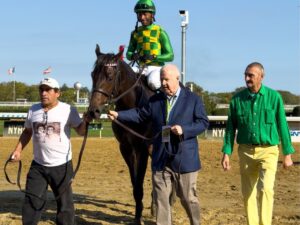
Recently, in the blog, I mentioned how the backbone of our stable is now made up of homebreds or horses that we purchased at Yearling or two-year-old sales. I thought I’d explain more about the purchasing process in today’s blog.
Myself and the owners (e.g. Mike Piazza of Zilla Stables) have a very thorough process. I personally attend the breeze shows and viewing days and normally leave before the sales start. By then I’ve done the work that I need to do and we’ve narrowed down our list of horses. At the end of the day I’m the trainer. The main thing for me is to see the horses breeze in front of me and then two or three times on the ground. We use Conor Foley as a bloodstock agent. We went through the Darley Flying Start program together and he is someone I trust immensely. We’ve had a lot of success with the horses we bought together at the sales. He’s an integral part of the team both at the sales and for private purchases. Conor does a lot of slow-motion replay watching on the horses. It’s not something I’m enormously familiar with, but it’s something he’s done for a long time. So if a horse makes both his list through the breeze show and my list, then we look at the horse at least three or four times and then have them vetted. Finally we value the horse to make sure the owner doesn’t spend more than we think the horse is worth.
One of the challenges when evaluating horses at these sales is how to evaluate a horse’s state of mind. Some of these babies at the breeze up sales already are in an incredibly fragile mental state. Especially some of them so highly trained for the sales. If there is a sale with 1200 horses in it and they breezed in the first day, there are four more days of Breeze shows going on and then three days for viewing. So these horses have gone from being fit to breeze to having to have a week of just showing. And that can really play with their minds a lot. I’m always looking for a horse that is very composed, and does what’s asked: walk, stand, don’t rear up, or be sweaty in the sales ring.
Two horses we had on our list at the April sale this year – we looked at in the back room before the sale. One of them flipped over and the other one completely lost his mind. He was completely washed out, he was a mess. So we did not bid on those horses. It’s very important they remain composed throughout the whole process. It’s a great opportunity for us to see how they’re going to handle being at the Belmont training track with 1,000 horses around them. Also, how they’ll handle the Paddock when they go over for the races.
Having endured all of this stress is why we give the horses we purchase a break after the sales. They are sent to a farm where they do a very light training in the morning and are turned out in the paddock or walked the rest of the day. We want them to get over these sales. These sales are an enormously stressful thing for these two-year-olds and we want them to know that’s not what the rest of their life is going to be about.
Overall, the horses we have bought at the sales tend to replicate what we’ve seen there. Obviously these breezed babies are a little bit more forward than the homebreds we get because they’re used to doing a little bit more. Often the homebreds we get have just been broken in when they’re sent here and they’ve never even been breezed before. The babies at the sales have been asked to run a faster eighth of a mile than they’ll ever be asked to run again, at a very early stage of their life.
Probably the horse that’s caught me off guard the most are by Kittens Joy, and I’m still learning about them as a breed. I have two of them. They are very hot individuals. Not in a bad way, but they do get hot and sweaty in the paddock before they run. Zandar is a good example. Before his first race this year, after a layoff, he got very washy in the paddock and was acting up. But as the year went on and he has had more races he’s gotten far calmer now. He’s always on his toes and jogging in the paddock. He’s also a typical sprinter, when he goes over to the races he knows it’s time.
All of this talk about homebreds and buying horses at sales might cause some readers to wonder about where we’re headed with claiming horses. We’re definitely trying to move away from the older claiming horses. A lot of people are very good at it and make a living out of it and occasionally strike gold with it. But now, with regards to claiming horses, I’m trying to concentrate on the horses that are younger, like maiden claimers or horses that have a condition left on them. They might’ve broken a maiden race but have conditions left on them with somewhere to go and they are only three or four years old.
So Tom Morley Stable can help if you need a trainer for your own homebred horses, or you need some help purchasing horses at sales and/or privately, and lastly we can work with you on claiming horses if your strategies are in align with ours.
-Tom Morley


